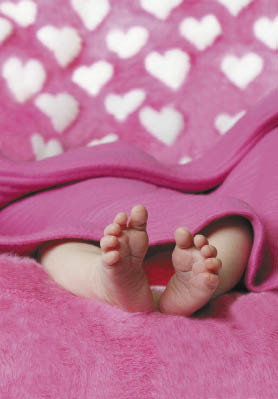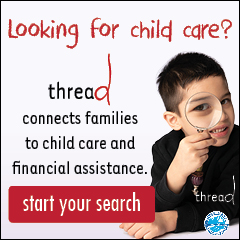
Easy as ABC
Reducing the Risk of Sudden Infant Death Syndrome
Story by Jamey Bradbury
The thought of a baby dying suddenly during sleep is one that keeps parents awake at night, fearing the worst. Sudden Infant Death Syndrome (SIDS) is the leading cause of infant death between 1 month and 1 year of age.
Every year, approximately 2,500 children die of SIDS in the US. It’s a frightening prospect because SIDS can strike without warning, usually in seemingly healthy babies.
While Alaska boasts one of the lowest neonatal mortality rates of the nation, our post-neonatal death rates are among the highest. “About half the deaths in that post-neonatal period are these sudden, unexplained infant deaths,” says Margaret Young, public health specialist with the Alaska Department of Health and Social Services.
However, the diagnosis of true SIDS is becoming less common, according to Debbie Golden, perinatal nurse consultant. “We’ve started to learn that a lot of infant deaths that were labeled SIDS were really unintentional suffocations. Parents may have heard that it isn’t preventable, yet the true cause of death for something labeled ‘SIDS’ often is preventable. There are a lot of things that can be done to stop babies from dying a sleep-related death.”
Preventing infant deaths can be as easy as ABC if parents remember three simple ways to keep their little ones safe at night:
A is for Alone
“Parents should room-share, not bed-share, because of the risks associated with bed-sharing,” says Golden. Infants can easily roll off an adult bed or become trapped between the mattress and the headboard.
The greater danger, though, can be the very people trying to keep baby safe: mom and dad. “A big factor we’ve seen in Alaska is maternal substance use,” says Young. “If the adult who sleeps with the baby is impaired in some way, that increases the risk a lot.”
When under the influence of any drug (such as alcohol or sleep medications), a parent’s sensitivity to a baby’s presence is diminished. Parents who are drunk or drugged are less likely to arouse from sleep if, for example, they accidentally roll over on an infant.
Older siblings sharing an infant’s bed can cause similar problems, since children tend to sleep heavily and might not be as aware of what’s around them.
“When we recommend ‘room-sharing,’ ” Young continues, “we mean the infant should sleep on a separate sleep surface but close to the mother because we do want to encourage breastfeeding. And, there are studies that show being able to hear the mother or the parents breathing helps regulate the breathing of the baby.”
B is for Back
While Alaska’s post-neonatal infant deaths are high, there is some good news, says Kathy Perham-Hester, coordinator with the Alaska Pregnancy Risk Assessment Monitoring System (PRAMS). “The trend for mothers placing their infants on their backs to sleep has gone up since 2000. The Back to Sleep campaign of the early ’90s did a lot to reduce SIDS in Alaska.”
Placing an infant on his or her back is one of the easiest ways to reduce the risk of sleep-related deaths. Back-sleeping also keeps a baby from choking because healthy babies are more likely to swallow any fluids they spit up if they are on their backs.
Positioning a baby on her back can also prevent re-breathing. “A baby may not actually be smothered,” says Golden, “but if her face is against the mattress when she’s positioned on her tummy, she may re-breathe air she exhaled that has a lower oxygen content. This can trigger a mechanism in the brain stem that causes certain babies to stop breathing.”
C is for Crib
Cribs should be free of blankets, stuffed animals and bumpers – anything, Golden says, “where, even if he’s positioned on his back, a baby’s face might be turned and the airflow around his face might be impeded.” Rather than using a blanket to keep infants warm at night, she recommends parents dress their babies in a wearable blanket or sleep sack.
The mattress is also important: It should be firm and should fit snugly to prevent the baby from becoming trapped between the mattress and the sides of the crib. The same recommendations can be applied to adult beds for those parents who still choose to bed-share. “A firm, flat surface is what you want,” says Perham-Hester. “No waterbeds, no couches.”
When selecting a baby’s crib, opt for standard cribs with slats spaced closely together. An easy way to gauge is to make sure a soda can wouldn’t fit between the slats. And while thrift stores and Craigslist can be great places to find bargains on a used crib, says Young, “avoid drop-side cribs, mostly because they can be put together wrong, so they’ve been known to fall and cause injuries or deaths.”
Other Factors
“If mom smokes or chews during pregnancy,” says Young, “it can affect the development of the baby, so an infant might not react as quickly if their airway is blocked. That’s a big factor because we have high rates of prenatal tobacco use in Alaska.”
Any smoke exposure increases the risk of infant sleep-related death, but third-hand smoke – the chemicals left behind in clothing or furniture – is a newer concern, says Golden. “When mom or dad holds the baby after coming in from a smoke, the baby is breathing in those chemicals left behind on their clothing.”
Alaskan mothers can prevent unforeseen circumstances from endangering their infants by planning ahead. “A lot of moms will come in from the village and stay with relatives in town who don’t have a crib, and babies end up sleeping in a less than ideal environment,” says Golden. She suggests that parents think beforehand about where their baby will sleep, whether it’s in a borrowed pack-and-play or in a drawer taken from a dresser and placed somewhere safe.
When it comes to SIDS, research has come a long way toward unwinding the mysteries surrounding this scary affliction, and informed parents are now able to take simple preventive measures that will help baby, and mom and dad, sleep a whole lot better.










